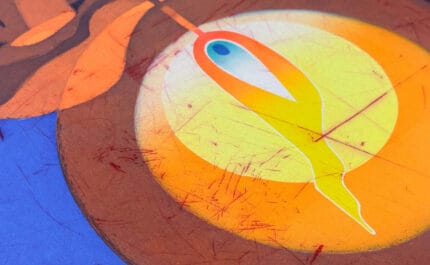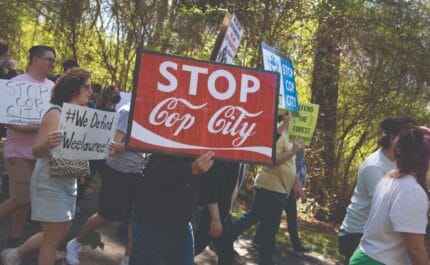Back to life
One man’s drive has brought the marshlands of Iraq back from the brink of destruction. Bob Tollast travelled to Iraq to see Azzam Alwash’s creation – and to hear how its future hangs in the balance
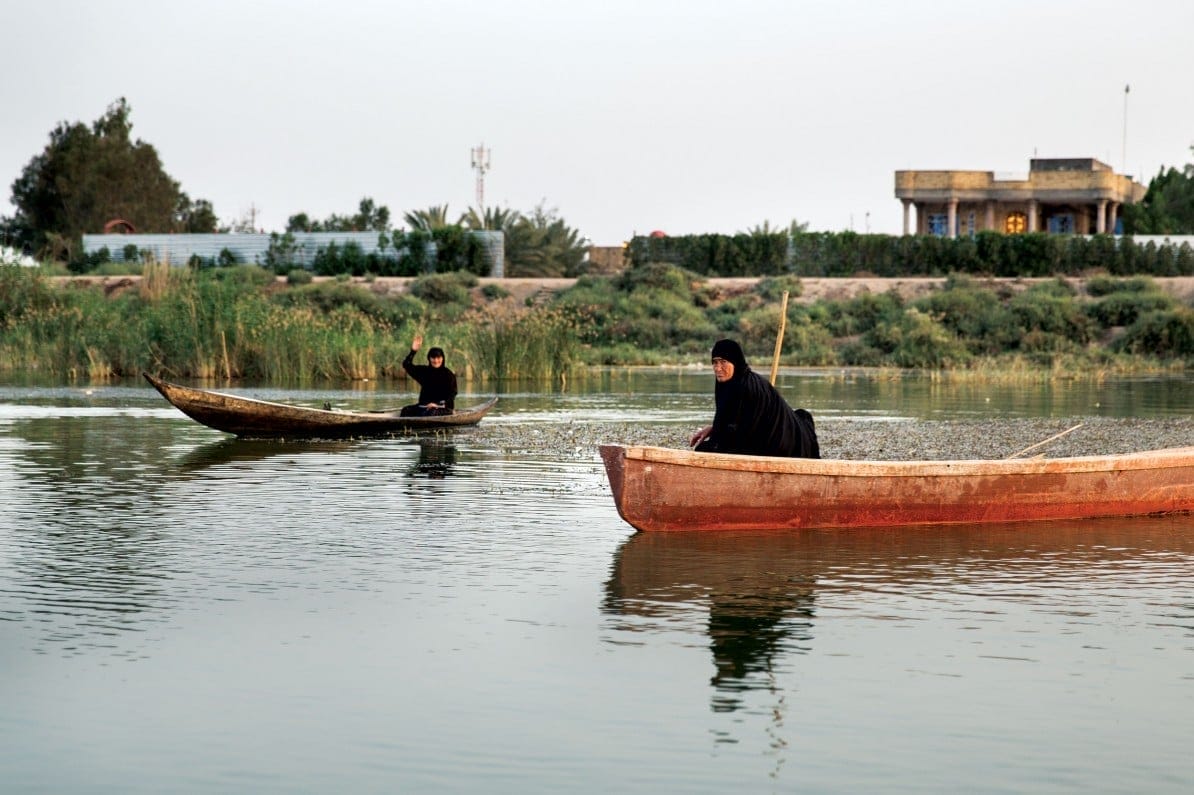
Photography: Scott Chasserot
15th February 2015 (Taken from: #18)
“These marshes don’t just belong to Iraq, they belong to humanity,” says Azzam Alwash, gazing out over an expanse of tall reeds and deep clear water. “This is where agriculture was invented, where writing was invented, where Abraham was born.”
We are in the Tigris-Euphrates marshlands of southern Iraq, the largest wetlands in the Middle East. Azzam spent his childhood here, hunting and fishing with his father. In recent years, he has become seen as the area’s champion, the man determined to protect it from myriad threats.
Azzam is driven – and tormented – by his memories of the former splendour of the marshes.

Azzam Alwash, CEO of Nature Iraq
It was a landscape that stunned the legendary British explorer Wilfred Thesiger when he arrived there in October 1950, Leica in hand. Cathedral-like mudhief structures, intricately made from thousands of bundles of reeds, nestled amid forests of bulrushes. As far as the eye could see, sun-dappled water, crystal clear and clean enough to drink, rippled under the bright blue sky.
By night Thesiger recalled how “starlight reflected on the dark water” as mothers told their children pre-Islamic folk tales about monsters that lived in the marshes, and the island paradise of Hufaidh that caused insanity in anyone who landed there. Here, recalled Thesiger, was “the stillness of a world that never knew an engine”.
When Thesiger visited, Marsh Arab culture had remained largely unchanged for countless generations. Fishermen punted their sleek mashoof canoes through narrow pathways in the towering reeds searching for plentiful carp to spear. Farmers tended their herds of water buffalo, an animal whose presence in the region dates back 5,000 years to the Uruk and Sumerian periods. Kingfishers, herons and geese paddled the waterways and more than 300 species of migratory birds were recorded in the area. This heavenly waterworld was thought by some to be the original Garden of Eden.
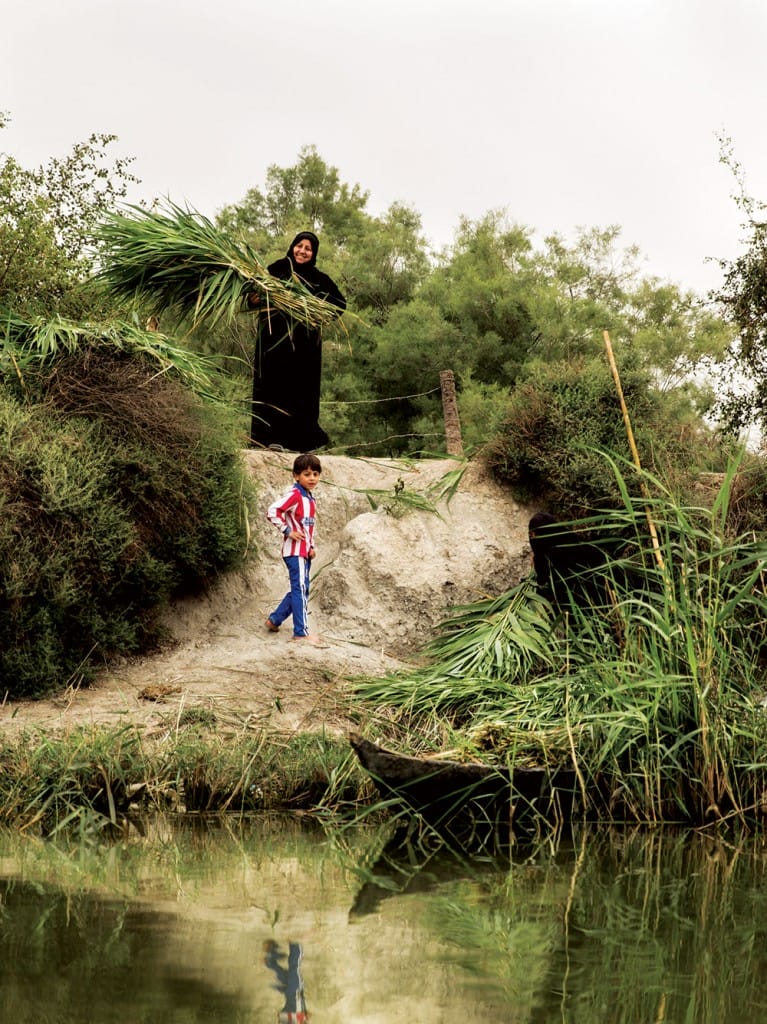
Iraq’s Sherwood Forest
Azzam was forced to flee Iraq in 1978 after refusing to join Saddam Hussein’s Ba’ath party. When he returned after the 2003 invasion, he found the marshes of his childhood had been turned into “a hell of ashes”.
The destruction began following the Gulf War in 1991. As the Iraqi army fled Kuwait under heavy attack from the US-led coalition, it suffered casualties in the tens of thousands when retreating columns were strafed from the air along the ‘Highway of Death’. Already exhausted and mutinous after an abortive eight year war with Iran that claimed over a million lives, a large group of Shi’a soldiers rebelled, urged on by George Bush Sr who asked them to “take matters into their own hands”. Many took his comment to mean impending coalition support, but this never came. Allowed to use helicopters within Iraq under a ceasefire agreement, Saddam redirected his elite Republican Guard units to crush the rebellion. As many as 100,000 died or were “disappeared” into one of the 200 mass graves uncovered after 2003. Surviving rebels fled to hide out in the marshes, what Azzam calls “Iraq’s Sherwood Forest”.
A population of 500,000 whose culture stretched back 6,000 years had been all but obliterated”
Saddam took drastic action. Six canals were dug to drain the area, the largest known as the “Victory canal”. With little construction happening in Iraq due to sanctions, earth-moving equipment was redirected to the south and the marsh water was channelled out of the area. ‘Military roads’ were constructed so that tanks could blast away at anyone hiding in the reeds, villages were shelled and reed mudhiefs were destroyed.
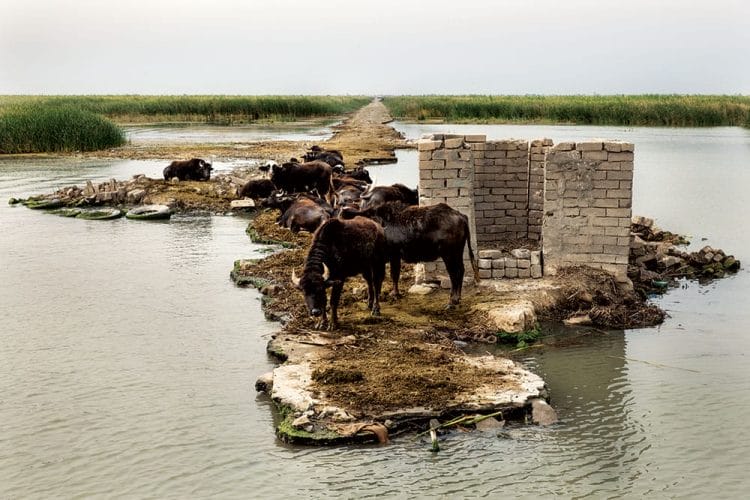
Buffalo have found a favourite spot on a derelict ‘military road’, built by Saddam Hussein to move armoured vehicles around the marshes
The ground was baked hard by fires from the dried reeds, as Saddam’s henchmen slashed, burned, mined and even poisoned the area. When the destruction came to an end, less than a thousand square kilometres of marshland remained from an area once bigger than Wales. Natural salt had leached to the surface, leaving the land infertile and useless. Before long, most of the Marsh Arabs were gone, scattered into urban slums across southern Iraq. A population of 500,000 whose culture stretched back 6,000 years had been all but obliterated.
It was into this post-apocalyptic setting that Azzam, a trained hydrologist, arrived in 2003. He became the CEO of Nature Iraq, an NGO set up to examine and improve the state of the marshes in a rare example of a post-war reconstruction of an ecosystem.
“In May 2003 we had a meeting in Geneva in which so-called ‘experts’ on the marshes claimed that they should not be restored and, interestingly, that the Marsh Arabs would not want them to be,” Azzam tells me. “That was a shock. I went back to Iraq two weeks later, under the impression that I was going to have to fight a war to get the marshes restored.”
But the experts claiming the marshes could not be revived were wrong. “It turns out that the Marsh Arabs had begun the restoration even before I came back by breaching embankments, by disabling pumping stations and doing all sorts of things that enabled the water to come back, although not in its natural form,” says Azzam. “The work was haphazard, mostly done by hand as locals did not have heavy equipment, and some embankments could not be breached.” Progress had to be slow and steady, as there was a risk that sudden inflows of water could shift surface salt deposits, creating nothing but dead lakes.
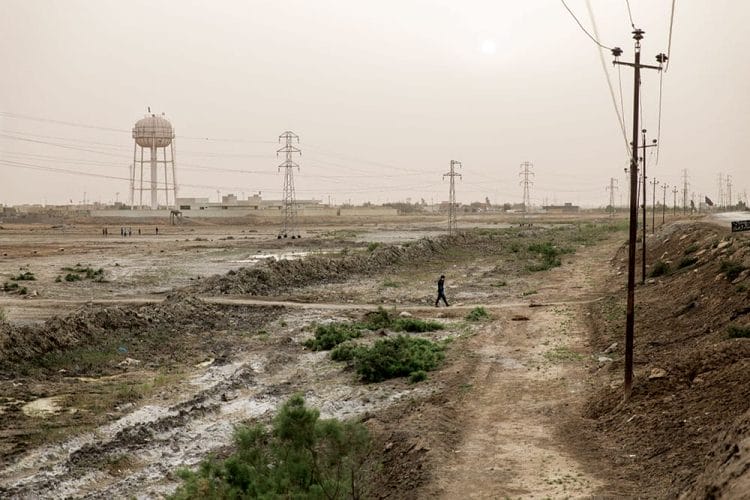
An expanse of dried marshland by the highway to Chibayish provides a stark reminder that not all of these wetlands can be restored
“For the first four or five months I looked at areas that had been reflooded and I noticed immediately that some were doing well and some areas were really having a hard time coming back. We needed to use scientific methods to identify those areas where we should direct the water, so we could effect the best restoration possible. I personally paid for three breaches at a very critical point that restored 2,000 square kilometres [in one go].”
Today as much as 40 percent of the marshes have returned, and many Marsh Arabs have come back, but numbers are far below the heyday of the community here: perhaps 50,000 from the original half a million. I had wanted to see for myself how much had been revived, but given the instability of Iraq I had wondered how wise it was to visit the area. Azzam convinced me: “You must hurry,” he told me over email, “the marbled teal are migrating north.” That sealed the deal: I had to meet the man who was more worried about birds than militias.
It’s perhaps no surprise that as we travel around the towns and villages of marshland with the Nature Iraq team, I feel as if I am in the presence of local heroes. Everywhere we go, people wave, smile and come to speak with us.
The memory of Saddam is still strong in Chibayish, a village with a picturesque promenade that hints at its former glory as a tourist destination. As many as 2,000 local residents were ‘disappeared’ from this area in a roundup by Ba’ath Party henchmen in 1992.
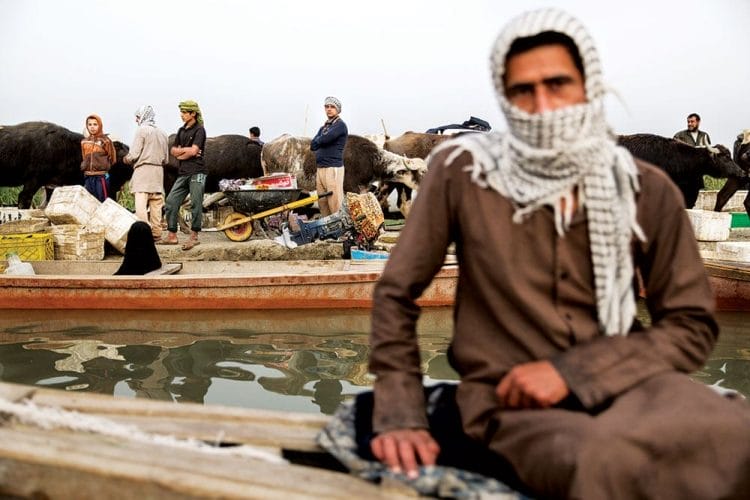
Fishermen line the causeway to take their haul to the market
Abu Haydar remembers this time well. At 72, he still has a wiry, muscular frame and sings throaty laments as he pushes our boat through the marshes with a long bamboo punt. But despite his songs of romantic heartbreak (we later learn that he has three wives) Abu Haydar is deeply content and is greeted cheerfully at every turn, laughing and joking with the fishermen as they haggle over the prices and quality of their catch. He tells me what it was like to live through the slow death of the marshes. “Day by day, month by month, the water was receding, the plants were dying back and there were no fish,” he says. “By 1992, everything was dead and the marshes became a part of the desert. The Euphrates water had become more saline, and our buffalo could not tolerate those conditions. People were in despair. So in 1993 I knew there was no use staying in Chibayish and went to work in an orchard, south of Baghdad.”
Abu Ali, a local fisherman, fled with 150 of his tribe when he was just five years old, at the end of the 1990s. He never thought he’d see the marshes again, but his small community returned together after 2003, having lived in slums in Najaf, several hundred kilometres to the north. “How did it feel, when you saw the marshes returning?” I ask. His response is emphatic: “It was like a dream.” He gestures out to the horizon. “I am like a fish,” he says, “I cannot live without the water.”
A threat upriver
Sadly, the golden age of the marshes recalled by Thesiger in his classic 1964 book The Marsh Arabs, may never return. This is because the region has been suffering the worst drought since 1970, a situation which is being exacerbated by Turkey’s ambitious Anatolia hydroelectric projects. An astonishing 1,783 new dams are scheduled to have been built by 2023, and when complete will radically reduce the levels of the Tigris and Euphrates downstream in Iraq. This could not only doom the marshes, but also threatens all of Iraq’s freshwater. Since 2009 the marshes have been retreating once more.
Dr Jassim al-Asadi fled Iraq with Azzam back in 1978 and returned to run Nature Iraq with him in 2003. In Chibayish, he points out where the water has dropped a metre in the past year alone, a line of dry slime marking the previous level. Already some Marsh Arabs have once again given up on the area and left, a sad development because as outsiders in the cities, their prospects are poor.
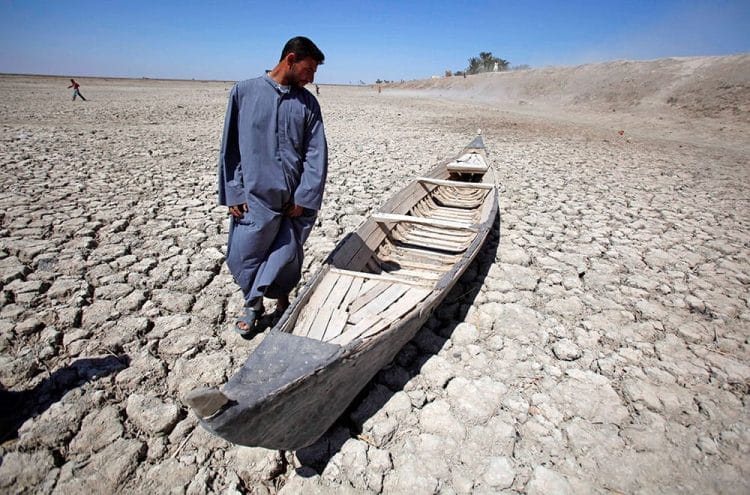
A man stands next to his boat in a dried marsh in Hor al-Hammar in southern Iraq. Photo: AP/Press Association Images/Hadi Mizban
But Azzam has a plan, not to save all of the marshes – this would be impossible – but to save what is left. At the Hammar marsh near Chibayish, earth works and pumping stations have been constructed to keep water in, a project completed with sponsorship from the Italian government. “We are using drainage water from the farms in the central marshes to re-flood Hammar marsh,” says Azzam. “The fortunate thing about marshes and reeds is that they can grow in brackish water. So we can use drainage water to restore a portion of the marshes and that is our long term plan.” The salty water will change the composition of the marshes, and some of the biodiversity will be lost as salinity increases: Azzam claims that this is preferable to continued destruction, and says they will remain a crucial breeding ground for migratory birds. It’s a characteristically bold scheme from a man who claims not to be “constrained by reality”.
The region has been suffering the worst drought since 1970, a situation which is being exacerbated by Turkey’s ambitious Anatolia hydroelectric projects”
The World Bank has refused to fund the new wave of Turkish dams and in 2009 Austria, Switzerland and Germany blocked companies from their countries from funding the projects, causing delays. Worries about water sharing are rising up the international agenda as a growing body of evidence suggests that a major factor sparking the current conflict in Syria was a long-term drought which destroyed agriculture and forced farmers to start new lives in the city, where jobs were scarce. Political instability followed. Amnesty International has condemned the dams and Friends of the Earth has said they risk “fermenting war in the Middle East”.

From the big mudhief meeting halls to these buffalo shelters, reeds provide the raw material for daily life in the marshes
Undaunted, Turkey has pulled together alternative private and state funding. It has never signed the main international treaty on transboundary water, in the UN Convention on the Non-Navigational Uses of International Watercourses. The international community lacks the means to challenge the country.
“If Iraq doesn’t do something, agriculture will die a slow death in the land where it was born,” says Azzam. “Something needs to happen to address the equitable water sharing and efficient and proper water management of the Tigris and Euphrates. Iraq’s current priorities are not agriculture or the environment, but mere survival. Regardless of the security issue, feeding the people will remain a priority. But you have to understand that international law only applies to the weak. Turkey is in NATO, and Iraq is the weak, subservient country that is being divided by proxy wars between its neighbours.”
Undeterred, Azzam is using his lobbying skills to explore the possibility of a water sharing agreement linked to energy sharing. Turkey has almost no oil, and has been forced to partner with Iraqi Kurdistan to meet its energy needs. The agreement has brought an unexpected peace dividend – after decades during which Turkey was at loggerheads with Iraqi Kurds, the energy cooperation has led to greater ties and a de-escalation of tension between the two sides. Azzam has hopes that something similar can happen with the current water dispute.
One plan Nature Iraq has been discussing with energy experts is a scheme in which Iraq buys much of the electricity generated from the Turkish hydroelectric power stations. This makes sense on paper, because as much as 40 percent of the electricity generated by the dams’ power stations will be lost in transit to Turkey’s industrial heartland around Istanbul. By contrast, Iraq seriously lacks power generating capacity, and is closer to the dams, which would theoretically allow more efficient supply. And if Turkey is trying to meet Iraq’s rising electricity demand in addition to its own needs, more water will have to gush through the hydroelectric dams and into Iraq. The approach faces a number of political and technical hurdles, but, Azzam thinks, would be far better than the current deadlock.
Sunset on Hammar
Azzam has burdened himself with a huge weight of responsibility for his beloved marshes. He has spent more than a decade on a project he initially thought might only take a couple of years. His quest led him to spend months at a time away from his California home, contributing to the failure of his marriage and meaning he has missed key family moments including the graduation of one of his daughters. And it hasn’t been without personal risk: security in the south is better now but in the past Azzam needed armed guards. As we talk, our conversation is interrupted by the news that Ammar al-Shahbander, head of the Iraq branch of the Institute for War and Peace Reporting, has been killed in Baghdad. Like Azzam, Ammar was once a member of Iraq’s large diaspora and became an early associate of his, working on the marshes project through The Iraq Foundation. Azzam is devastated by the news.
Despite all the challenges ranged against him, it is clear that Azzam is not going to give up on Iraq for a safer life in the West. He still buzzes with childlike excitement when talking about the marshes, and he maintains that they have become his “mistress”.
As you sit and watch men and women glide by in their mashoofs as the dawn glows off Hammar marsh, it’s hard not to feel compelled by the idea that this magical place must survive”
In May 2015, Nature Iraq received a grant from the Swiss government to continue work on the marsh restoration. It was a welcome boost at a difficult time, and has given Azzam renewed belief in his mission. “Knowing what I know, I can never feel that the marshes have been [fully] restored,” he says. “But that’s a personal problem – those who did not experience the marshes in their glory days are oblivious to the changes that have occurred. In a sense, they see the essence of the marshes. Does that mean that new marshes are not good? No! Of course not. It means that the only constant in nature is change.”
As you sit and watch men and women glide by in their mashoofs as the dawn glows off Hammar marsh, it’s hard not to feel compelled by the idea that this magical place must survive. But what if the real danger is not the end of the marshes – a small area in the grand scheme of things – but a lack of water in all of Iraq? It could be argued that in order to maximise its water supply, Iraq might have to let go of the marshes once again.
Azzam insists that they have a major psychological value, which has only been increased by the suffering in Iraq’s recent history. The definitive end of the marshes would be as though the Lake District disappeared, he says, or if one day the French woke up and there was no Massif Central. “To me the restoration of the marshes represents literally the rising of the Iraqi Arabs from the ashes of destruction,” he says. “It is a symbol of the eternity of the Tigris and Euphrates. It is a symbol of the eternity of Iraq.”
Slow Journalism in your inbox, plus infographics, offers and more: sign up for the free DG newsletter. Sign me up
Thanks for signing up.
